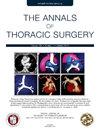种族、乡村和收入在确定微创肺部手术可及性方面的交集。
IF 3.6
2区 医学
Q1 CARDIAC & CARDIOVASCULAR SYSTEMS
引用次数: 0
摘要
背景:种族对医疗保健服务的获取有着强有力的影响。地理位置和收入可能对患者的预后产生同等或更大的影响。我们试图确定种族、农村和收入的交集,以及它们对医疗保险受益人获得微创肺手术的影响。方法利用医疗保险和医疗补助服务中心的数据,评估2018年至2020年期间通过开放式、机器人辅助胸外科手术(RATS)或视频辅助胸外科手术(VATS)接受右上肺叶切除术的肺癌患者。国际疾病分类,第10版,被用来定义诊断和程序。我们排除了叶下、节段性、楔状、支气管成形术或有非恶性或转移性疾病或新辅助化疗史的再手术患者。采用广义线性模型和Cox比例风险模型,采用治疗加权逆概率(IPTW)倾向评分进行风险调整。结果该队列包括13404例患者,4291例(32.1%),4317例(32.2%),4796例(35.8%)VATS。黑人/城市患者的rat和VATS率显著较高(P <;.001),更长的长期生存期(P = .007),更少的切开切除(P <;.001),总体死亡率较低(P = .007)。低收入黑人/城市患者有较高的RATS (P = 0.002)、VATS (P <;.001),更长的长期生存(P = .005),更少的切开切除(P <;.001),总体死亡率低于农村白人患者(P = .005)。结论:生活在联邦贫困线附近的农村白人可能承受着传统上在贫困黑人中观察到的差距负担。这表明需要制定卫生政策,将服务扩大到贫困的农村地区,以减轻健康的社会决定因素。本文章由计算机程序翻译,如有差异,请以英文原文为准。
Intersection of Race, Rurality, and Income in Defining Access to Minimally Invasive Lung Surgery
Background
Race is a potent influencer of health care access. Geography and income may exert equal or greater influence on patient outcomes. We sought to define the intersection of race, rurality, and income and their influence on access to minimally invasive lung surgery in Medicare beneficiaries.
Methods
Centers for Medicare and Medicaid Services data were used to evaluate patients with lung cancer who underwent right upper lobectomy, by open, robotic-assisted thoracic surgery (RATS), or video-assisted thoracic surgery (VATS) between 2018 and 2020. International Classification of Diseases, 10th Edition, was used to define diagnoses and procedures. We excluded sublobar, segmental, wedge, bronchoplasty, or reoperative patients with nonmalignant or metastatic disease or a history of neoadjuvant chemotherapy. Risk adjustment was performed using inverse probability of treatment weighting (IPTW) propensity scores with generalized linear models and Cox proportional hazards models.
Results
The cohort comprised 13,404 patients, 4291 open (32.1%), 4317 RATS (32.2%), and 4796 VATS (35.8%). Black/urban patients had significantly higher RATS and VATS rates (P < .001), longer long-term survival (P = .007), fewer open resections (P < .001), and lower overall mortality (P = .007). Low-income Black/urban patients had higher RATS (P = .002), VATS (P < .001), longer long-term survival (P = .005), fewer open resections (P < .001), and lower overall mortality compared with rural White patients (P = .005).
Conclusions
Rural White populations living close to the federal poverty line may suffer a burden of disparity traditionally observed among poor Black people. This suggests a need for health policies that extend services to impoverished, rural areas to mitigate social determinants of health.
求助全文
通过发布文献求助,成功后即可免费获取论文全文。
去求助
来源期刊

Annals of Thoracic Surgery
医学-呼吸系统
CiteScore
6.40
自引率
13.00%
发文量
1235
审稿时长
42 days
期刊介绍:
The mission of The Annals of Thoracic Surgery is to promote scholarship in cardiothoracic surgery patient care, clinical practice, research, education, and policy. As the official journal of two of the largest American associations in its specialty, this leading monthly enjoys outstanding editorial leadership and maintains rigorous selection standards.
The Annals of Thoracic Surgery features:
• Full-length original articles on clinical advances, current surgical methods, and controversial topics and techniques
• New Technology articles
• Case reports
• "How-to-do-it" features
• Reviews of current literature
• Supplements on symposia
• Commentary pieces and correspondence
• CME
• Online-only case reports, "how-to-do-its", and images in cardiothoracic surgery.
An authoritative, clinically oriented, comprehensive resource, The Annals of Thoracic Surgery is committed to providing a place for all thoracic surgeons to relate experiences which will help improve patient care.
 求助内容:
求助内容: 应助结果提醒方式:
应助结果提醒方式:


